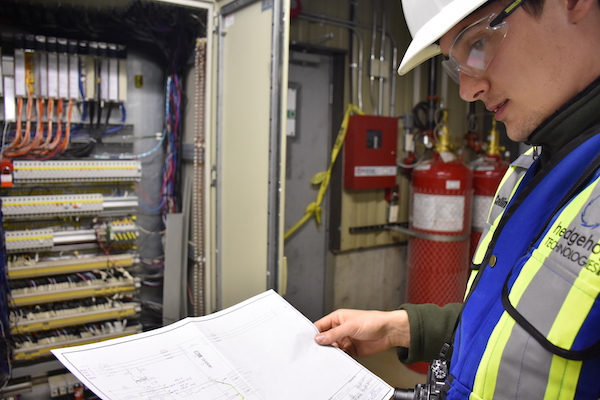
The importance of maintenance documentation
May 5, 2020
By Michael Wrinch, P.Eng., and Matthew Keeler, P.Eng.
Functional safety is a key process.

Photo credit: Hedgehog Technologies.
Operators of complex machinery are always faced with a challenge: equipment has a lifespan and without proper maintenance, a breakdown is inevitable. To ensure efficient operations and an acceptable level of safety, a system of regular documentation of maintenance can mean the difference between a safely managed facility and a catastrophic failure.
Ensuring functional safety
‘Functional safety’ is an important process that mitigates hazardous events for active equipment. The International Electrotechnical Commission’s (IEC’s) most senior safety standard in this respect, IEC 61508, describes a holistic approach to engineering as a requirement to determine a new system’s safety rating, with methods for designing, deploying and maintaining automatic protection systems.
Another benefit of this standard is it allows for proactive product management throughout the equipment’s life cycle, which begins with concept design and risk reduction, then continues with realization, maintenance and, eventually, decommissioning.
Without an understanding of the full scope of a system’s operational integrity, the risk of failure will increase throughout the product’s useful life. This can compromise safety and expose the operator to liability issues.
Record-keeping is an essential component of functional safety, throughout all stages of a product’s life. Common wisdom may suggest the only required documentation comprises the design files and the manufacturer’s operations manuals, but to ensure proper functional safety over the longer term, it is also crucial to keep records of all interactions with the machine throughout its use.
This will involve documenting the product’s various operations and maintenance (O&M) stages. Any time a part is serviced or altered in any way, those changes need to be recorded.

Figure 1
Understanding failures
When a product enters O&M, there needs to be a management model in place (see example in Figure 1 above). The resulting reports should be stored in a database, so as to keep a record of all events regardless of their outcomes and then to determine if a failure can be considered systemic or random.
Systemic failures are difficult to detect and will benefit from historical data trends to support analysis. Random failures, on the other hand, involve comparisons between actual data and risk analysis data. If there is a disparity, the risk analysis requires an update and a modification request can be submitted, so as to adjust the product accordingly. The outcome of a maintenance report does not mean the product should be modified, but it is a clear process that any operators who support the product can understand with ease. This operational transparency prevents non-essential replacements and reduces unforeseen systematic hazards.
By way of example, consider a new thrill ride for an amusement park, designed for an overall lifespan of 20 years, but with components of the overall system requiring planned servicing every five years, along with unplanned maintenance when events occur. Now assume a new operator takes over the ride, but without documentation to support decision-making. How would they know when the components require servicing? And could the ride be considered safe without historical information?
In North America, accountability for functional safety falls on the owner, who is ultimately responsible and liable for operations—but engineers can also find themselves liable if they are negligent in their duty of care. Indeed, owners can gain liability protection by hiring consulting engineers to oversee their system documentation. It is in the owner’s best interest to recognize severe risks, take the initiative to hire a consultant and have them help create a process to manage equipment, so in the event of failure, there is a recorded history of preventative measures that can be reviewed.
Lacking a plan
What if there is no maintenance plan for currently operational equipment? Don’t worry. This is a very common issue.
The most important and first step is to gain buy-in for the creation of a plan. This will involve ensuring managers know when tracking begins, as more incidents will seemingly appear throughout the process. A transparent maintenance system will reveal many recorded events for the machine in question; it’s no different from what was happening prior to tracking, except not there will be an established record.
Once buy-in is achieved, the next step is to (a) develop an internal plan or (b) bring in a functional safety engineer to support the development of a maintenance plan and a process to maintain, track and monitor the product.
At this point, the organizational culture may require special attention, as the maintenance team will have access to the information, which brings up a concern with traceability. Having a conversation about the benefits with the team will address fears that if the records are stored, the team will increase their liability through documentation and might be subject to legal action or, if something goes awry, it will result in a personal loss of work or harm to their reputation. They should be reassured the process is only intended to foster continual improvement and safer experiences for users, operators and maintenance team members alike.
Trusting the process
There are no guarantees when it comes to functional safety and even a well-tuned machine can experience a random failure, but what can be controlled is the likelihood of risk exposure.
The involvement of a functional safety engineer can lead to a deeper comprehension of both the functionality and integrity of the system, so as to best mitigate any oncoming issues. Keeping on top of maintenance documentation is important to the success of the organization, the product’s lifespan and the users’ safety.
Michael Wrinch, P.Eng. and Matthew Keeler, P.Eng. are functional safety engineers with Hedgehog Technologies, a risk management and electrical engineering consulting firm. They are both certified to international safety standards through TÜV Rheinland.